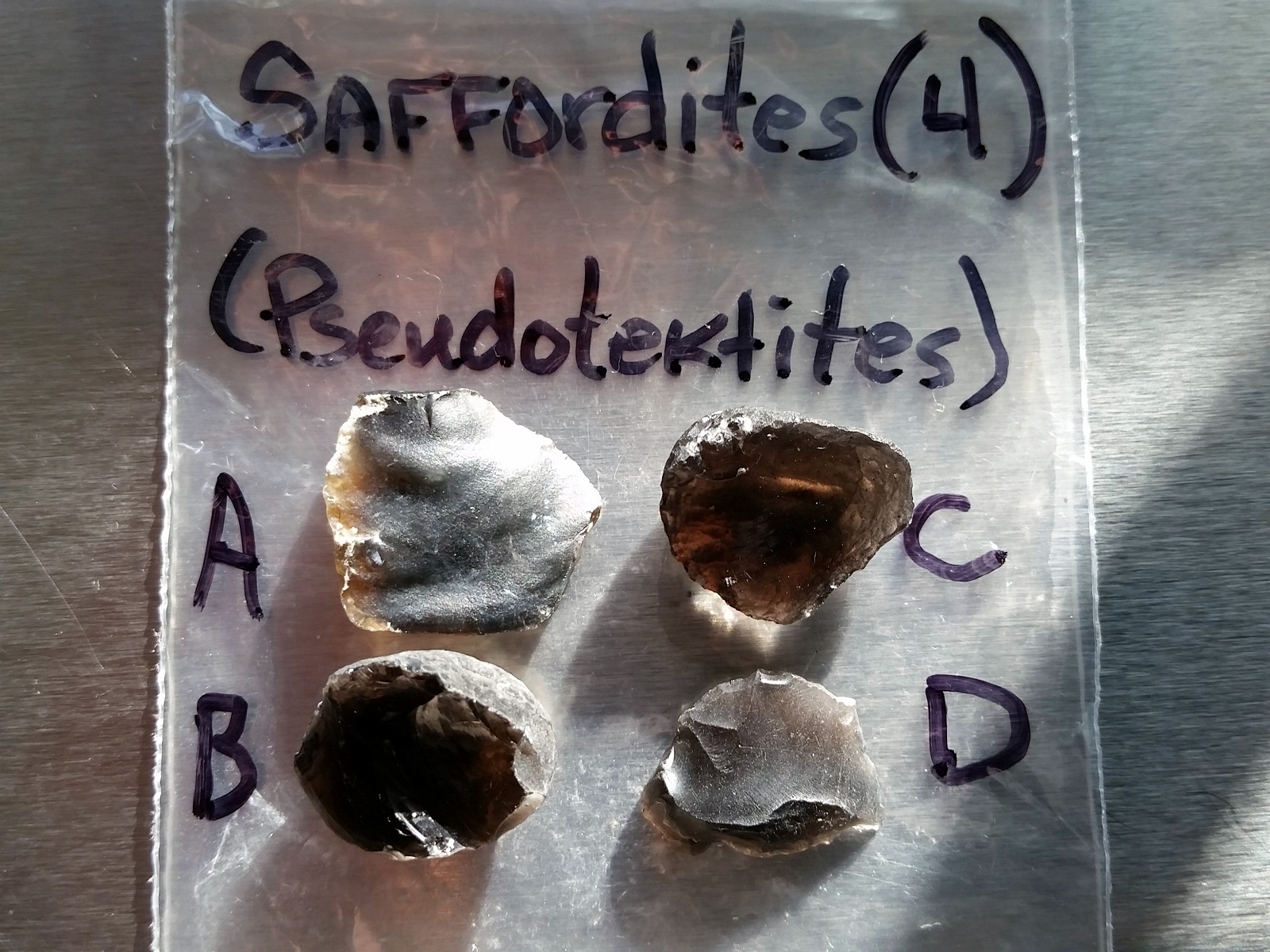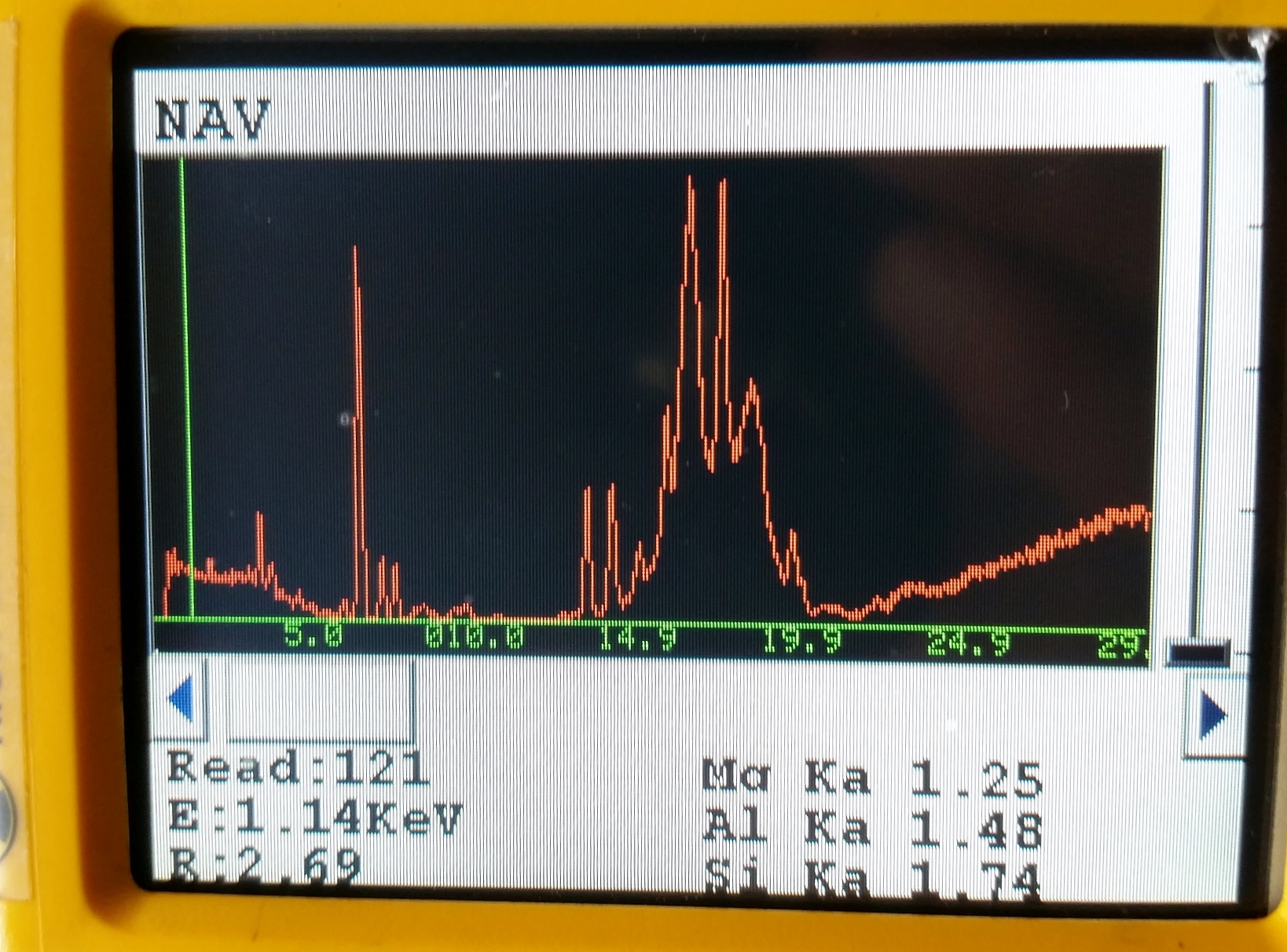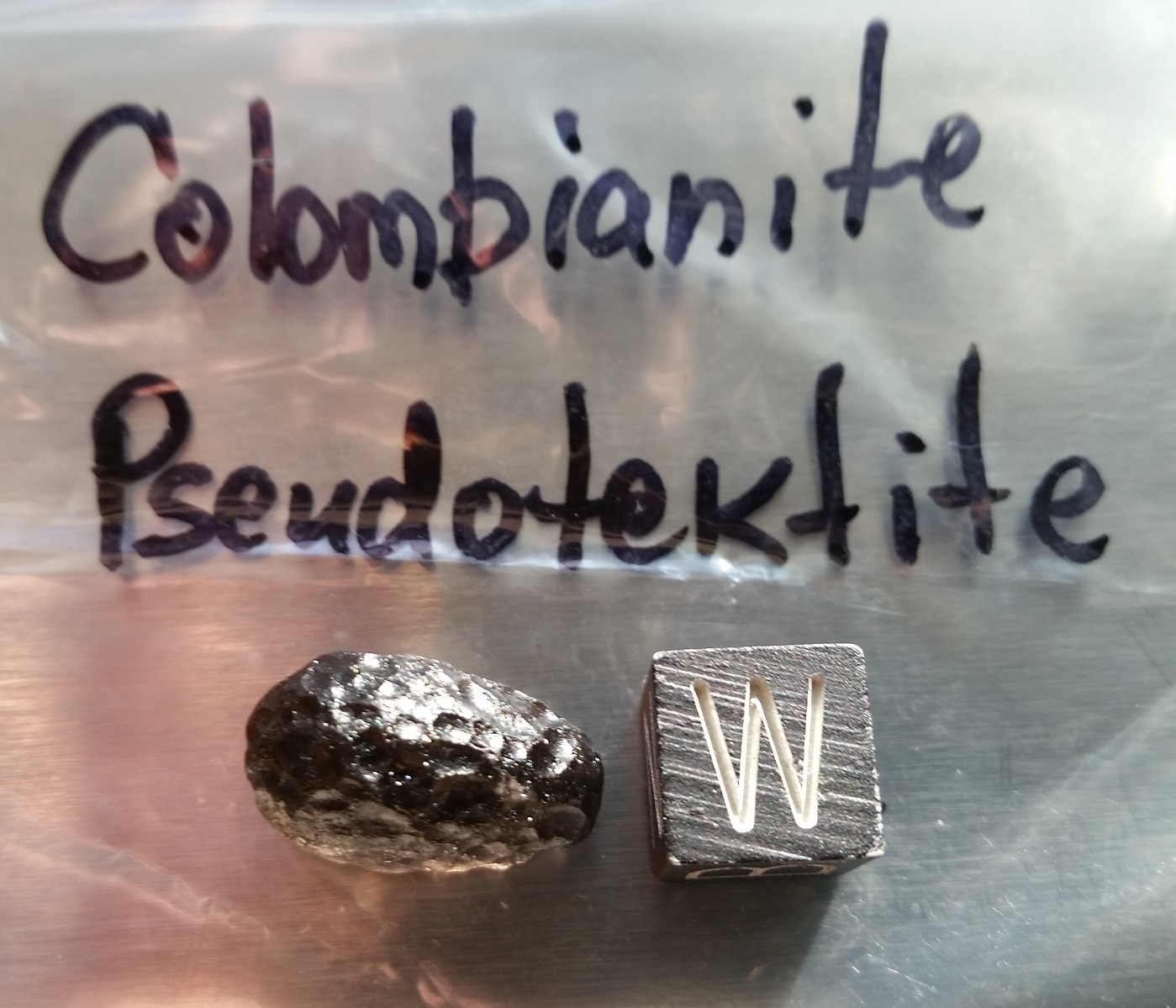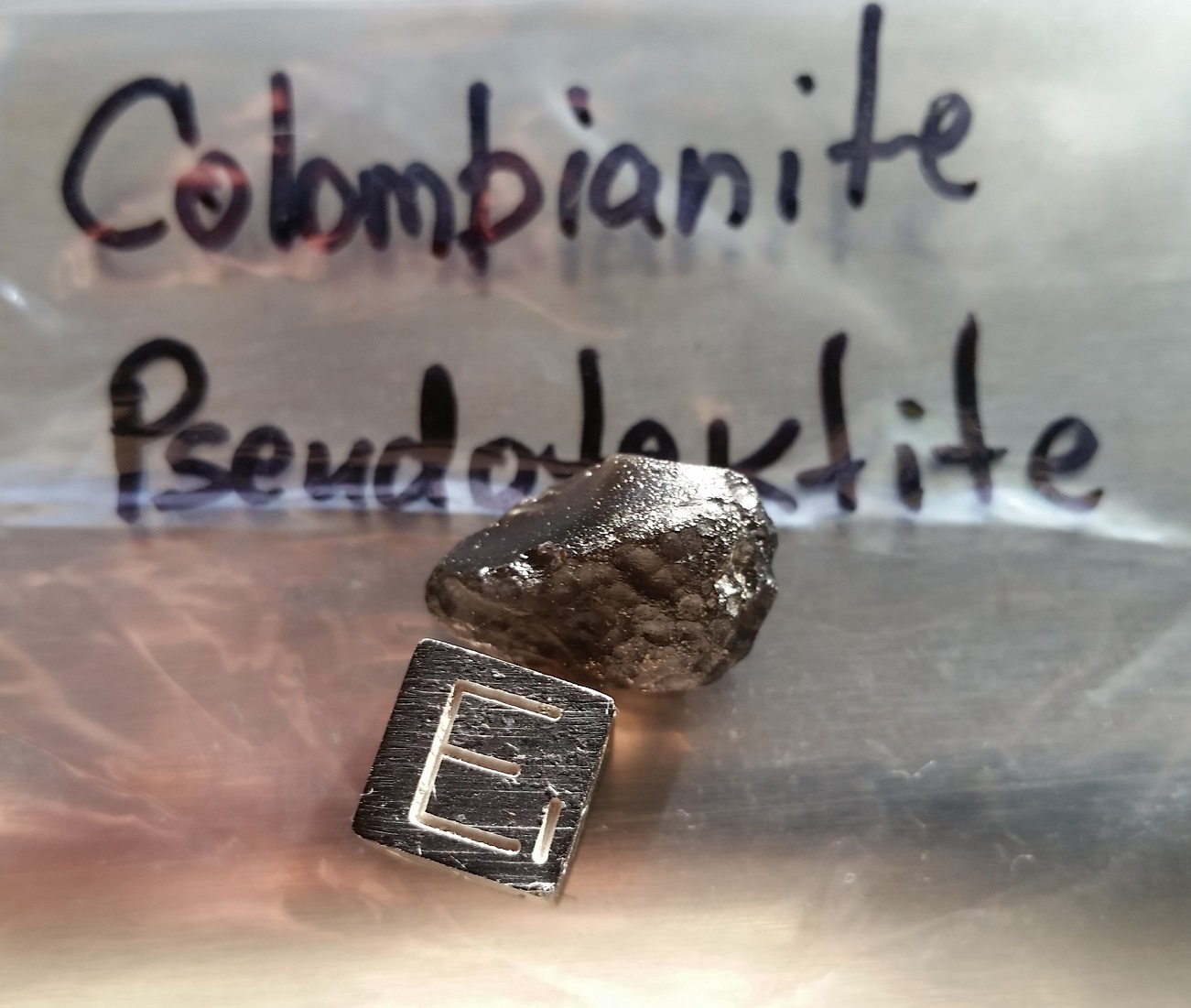![]()
Part 2 - Is it a Tektite or is it an Obsidian Pseudo-tektite?
Preliminary results from quick tests with a handheld XRF show that you can tell the difference.
Recently I was able to get access to a hand-held XRF analyzer (a Thermo Niton XL2 GOLDD unit). After much delay due to hardware problems and scheduled maintenance, I was finally able to test the various specimens of tektites, impactites, and obsidian that were described in my March 2016 – Part 1 article, “Is it a Tektite or is it a Pseudo-tektite“. As I explained in my Part 1 article, “portable XRF analyzers” are becoming more common-place, and are affording the layperson cheaper and quicker spectrographic analysis of metal, mineral, and rock specimens. In the past, this kind of analysis required expensive equipment that was larger, more labor intensive, and time consuming, which would price the testing of mundane material (such as, obsidian and other natural glass) right “out of the market”.
Even with the very limited time that I had the XRF available to me, I was still able to test sixty (60) specimens of various tektites, pseudo-tektites, impactites, and a variety of volcanic glass (obsidian). The Thermo Niton XL2 can output its readings in the form of an .XLS file. With this file I was able to sort all of my specimens in increasing percentage of titanium (%Ti) composition. The report form of this sort (see below) essentially self-segregates the obsidian samples from the tektite specimens. In order to better show this self-grouping I've color-coded the fields for ranges of %Ti that are above and below a certain arbitrary value (here, I chose 0.02%Ti), and another color for all values below a lower limit of detection (<LOD) for this handheld unit.
Prior to this testing, I had made the observation that earlier measurements of %Ti for obsidian and for tektites never appeared to overlap. The purpose of this testing is to see if these 60 additional measurements would continue this non-overlapping of %Ti values between obsidian and tektites. The results of these 60 additional measurements in essence show no overlap in %Ti values. Generally speaking (ignoring some “notable exceptions”), and as I stated in my Part 1 article:
The results for actual tektites should have %Ti values that range above 0.2%, and
the results for obsidian specimens will have %Ti values that are below 0.2%.
Impactites have shown a wider range of values, not only going well above 0.2%, but going below 0.2%, as well, thereby overlapping obsidian and tektites. This "fact" raises several questions which I would like to find answers, but that pursuit is outside the focus of this study. I've included impactite measurements here for the reader's convenience, and only ask that this be remembered when my discussion turns towards a peculiar volcanic glass that I self-collected in Nevada, and that I am calling "obsidian" (but XRF readings suggest that it may actually be an impactite, which makes it one of the "notable exceptions" mentioned above).
Again, if the specimens that I collected in Nevada are actually impactite, then all of the specimens that are actually obsidian are indeed "below 0.2%Ti", and all of the actual tektites are indeed "above 0.2%Ti", which shows that there is no overlap -- see below:
| Index | SAMPLE | NOTE | %Ti | ± 2 s Ti Error |
| 27 | V-obs-mahog | purchased Mahogany obsidian | < LOD | 0.078 |
| 29 | V-obs-snowflake | purchased snowflake obsidian | < LOD | 0.139 |
| 31 | V-obs-snowflake-120 | purchased snowflake obsidian | < LOD | 0.096 |
| 57 | V-tek-Troy-glass | man-made glass | < LOD | 0.135 |
| 59 | V-tek-TX_Troy03 | tests + for obsidian not tektite | < LOD | 0.151 |
| 60 | V-tek-TX_Troy04 | tests + for obsidian not tektite | < LOD | 0.105 |
| 61 | V-tek-TX-Troy09 | tests + for obsidian not tektite | < LOD | 0.105 |
| 63 | V-tek-Molda-Troy06 | very poor quality Moldavite | < LOD | 0.112 |
| 101 | V-tek-Ameri-Philipp | Amerikanite, Philippines | < LOD | 0.101 |
| 102 | V-tek-Apache | obsidian | < LOD | 0.103 |
| 103 | V-tek-ApacheB | obsidian | < LOD | 0.112 |
| 105 | V-tek-Norm-Bedias01 | tests + for obsidian not tektite | < LOD | 0.138 |
| 108 | V-tek-Norm-Columbi | Columbianite | < LOD | 0.107 |
| 118 | V-tek-Norm-SaffordA | Safford, AZ obsidian | < LOD | 0.106 |
| 119 | V-tek-Norm-SaffordB | Safford, AZ obsidian | < LOD | 0.109 |
| 120 | V-tek-Norm-SaffordC | Safford, AZ obsidian | < LOD | 0.147 |
| 121 | V-tek-Norm-SaffordD | Safford, AZ obsidian | < LOD | 0.115 |
| 128 | V-obs-Tobin-magnetic01 | Black Rock Nevada obsidian | < LOD | 0.11 |
| 132 | V-obs-Tobin-magnetic11 | Black Rock Nevada obsidian | < LOD | 0.119 |
| 165 | V-tek-A-8.17 | obsidian sold as tektite Hungary | < LOD | 0.109 |
| 166 | V-tek-B-7.95 | obsidian sold as tektite Hungary | < LOD | 0.104 |
| 167 | V-tek-C-7.64 | obsidian sold as tektite Hungary | < LOD | 0.101 |
| 168 | V-tek-D-5.5 | obsidian sold as tektite Hungary | < LOD | 0.098 |
| 169 | V-tek-E-4.12g | obsidian sold as tektite Hungary | < LOD | 0.104 |
| 171 | V-obs-Healds-not_obs | not obsidian, nor tektite ?slag? | < LOD | 0.092 |
| 173 | V-obs-BlkRckite20.9g | Black Rock Nevada obsidian | < LOD | 0.142 |
| 114 | V-tek-Norm-LDG | Libyian Desert Glass (tektoid) | 0.131 | 0.064 |
| 122 | V-tek-Norm-Zhamanshin | Zhamanshinite (impactite) | 0.136 | 0.069 |
| 129 | V-obs-Tobin-magnetic026 | Black Rock Nevada obsidian | 0.166 | 0.066 |
| 109 | V-tek-Norm-Darwin | Darwin glass (impactite) | 0.173 | 0.071 |
| 126 | V-obs-Tobin-No_mag | Black Rock Nevada obsidian | 0.174 | 0.066 |
| 25 | V-obs-whole-stone | Black Rock Nevada “obsidian” | 0.176 | 0.006 |
| 172 | V-obs-BlkRckite4g | Black Rock Nevada “obsidian” | 0.191 | 0.065 |
| 117 | V-tek-Norm-Rizalite B-side | Rizalite, Philippines | 0.201 | 0.073 |
| 124 | V-obs-Tobin-uncert | Nevada, but tests + for tektite! | 0.208 | 0.064 |
| 62 | V-tek-Riza-Troy05 | purchased Rizalite, Philippines | 0.222 | 0.074 |
| 131 | V-obs-Tobin-magnetic08 | Black Rock Nevada “obsidian” | 0.233 | 0.066 |
| 115 | V-tek-Norm-Muong | Muong Nong | 0.239 | 0.075 |
| 65 | V-tek-Austr-Troy08 | purchased as Australite tektite | 0.24 | 0.071 |
| 111 | V-tek-Norm-IndochiB | Indochinite | 0.24 | 0.075 |
| 107 | V-tek-Norm-Bedias03 | Bediasite | 0.247 | 0.07 |
| 130 | V-obs-Tobin-magnetic05 | Black Rock Nevada “obsidian” | 0.275 | 0.067 |
| 125 | V-obs-Tobin-imag01 | Black Rock Nevada “obsidian” | 0.276 | 0.065 |
| 112 | V-tek-Norm-Irghiz01 | Irghizite (impactite) | 0.298 | 0.068 |
| 58 | V-tek-TX_Troy02 | Troy Bell find LaGrange TX | 0.308 | 0.072 |
| 110 | V-tek-Norm-Indochi | Indochinite | 0.311 | 0.074 |
| 104 | V-tek-Norm-Austral | Australite | 0.313 | 0.077 |
| 127 | V-obs-Tobin-heated | Black Rock Nevada “obsidian” | 0.316 | 0.068 |
| 28 | V-obs-Tektest2012 | purchased as Indochinite tektite | 0.347 | 0.052 |
| 113 | V-tek-Norm-Irghiz02 | Irghizite (impactite) | 0.388 | 0.08 |
| 142 | V-rck-Myst-TL29 | Takysie Lake Pseudometeorite | 0.406 | 0.07 |
| 64 | V-tek-Thai-Troy07 | purchased as Thailand tektite | 0.463 | 0.067 |
| 106 | V-tek-Norm-Bedias02 | Texas, Bediasite | 0.477 | 0.071 |
| 145 | V-rck-Myst-TL53005 | Takysie Lake Pseudometeorite | 0.492 | 0.074 |
| 143 | V-rck-Myst-TL53002 | Takysie Lake Pseudometeorite | 0.534 | 0.071 |
| 66 | V-tek-Thai-Troy07inclu | oxide-rich inclusion in tektite | 0.55 | 0.08 |
| 160 | V-imp-Lonar Crater-1 | India, impactite | 0.786 | 0.136 |
| 159 | V-imp-Lonar Crater-1 | India, impactite | 1.173 | 0.106 |
| 158 | V-rck-LV130525 | probably man-made “slag” | 1.454 | 0.099 |
| 98 | V-min-myst05 | titanite in ilmenite-magnetite | 9.783 | 0.112 |
| 99 | V-min-myst05B | titanite in ilmenite-magnetite | 9.935 | 0.181 |
"NOTABLE EXCEPTIONS":
Among the specimens that were measured with an XRF and gave readings "above 0.2%Ti", the only notable exceptions were my very own self-collected Nevada natural glass specimens that I self-labeled as "obsidian". But they may be something else. For instance, they could be impact-glass, and in that case their XRF readings wouldn't be anomalous, and then they wouldn't be a "notable exception".
Make no mistake, these specimens are not tektites. I had these same specimens tested by Jim Tobin, and they all failed to pass his criteria for being a tektite.
All except for one small, round stone which Jim has labeled as "Uncertain".
I had no reason to expect this particular specimen to be any different from the many other opaque-black, non-magnet-attracting, round "Apache Tears" (or "marekanites"), that can be collected by the dozens along the margins of most playas.
But, when this little stone underwent Tobin's torch-test and it did nothing, that was much unexpected! It was heated beyond its melting point and it still did not change, which is a positive test for being a tektite. There was no cracking, or splintering, or white-frosting of the edges, let alone foaming of the glass, which is a positive-test for obsidian.
Although I wouldn't go so far as to say that "this proves it is a tektite", I would say that, until a more sophisticated testing method is utilized, it is indistinguishable from a tektite.
This finding could be significant because a recent hypothesis has predicted that, although tektites are found in mapable strewn-fields where the majority have densely fallen, there is no reason to rule-out that, once having gone sub-orbital, a few stones could have traveled farther down-range resulting in the possibility of these vagrant tektites having fallen far outside their "mapped strewn-field", essentially anywhere. In time, as technical advances are made, and as we look closer and closer, we may find more and more "surprises", such as this little black anomaly masquerading as an Apache Tear.
As far as the other Nevada specimens are concerned, although this torch-testing excludes those specimens from being tektites, it doesn't rule-out that they are impactites.

The Libyan Desert Glass (LDG) sample was a cloudy-whitish color.
Among the 10 samples that had values that were hovering around this 0.2%Ti-level (where 5 were above and 5 were below this arbitrarily selected value), there were six (6) that were my Nevada specimens. Bracketing my 6 specimens and the 2 Rizalites were an impactite (Darwin Glass) and a splashform (Muong Nong). These 10 specimens (which were 1/6th of the samples I tested) formed a field of results, which (when you consider the ± 2 σ Ti Error) define what I mean by specimens with "borderline" readings.
For the reader's convenience, I've highlighted in yellow the sub-0.2% specimens.
There were a number of notable exceptions here in this group, if you consider specimens being labeled as "tektite" but in reality being obsidian as being notable. For instance, my neighbor had a small collection of glass nodules that were labeled as "Tektites from Hungary", which he had purchased several decades ago, but when tested they were shown to be obsidian.
If you don't consider these instances of misidentification as being "notable", then there are only 2 specimens on my list that need to be discussed.
V-tek-Norm-Bedias01
A good friend and long-time tektite collector, Norm Lehrman, lent me a sample of every major category of tektite and impactite from his collection for the purpose of this testing. One of the many bags that he had sent to me was labeled "Bediasite", but it contained three (3) samples. I debated whether I needed to analyze all three, because at first, they all looked so similar, but I finally decided to test all three. That turned-out to be a good decision, because the three test results were widely spread. In fact, the "Bedias01" sample tested "<LOD" for Ti which means it tested too low to be a tektite. This caused me to re-examine the three samples very closely, and while using microscopic magnification, I eventually realized that there were differences among them. Hopefully, the reader can see the diagnostic differences in the above image. "Bedias02" has had its surface sufficiently etched to reveal the tightly-spaced laminations typical of tektites, whereas, "Bedias01" has on its surface a conchoidal fracture that reveals a cloudy inclusion that is often seen in obsidian but not in tektites.
I'm not sure, but I think Norm was testing my identification skills, and if I passed, it was only "by the skin of my teeth".
V-tek-Molda-Troy06
Another old friend lent me some specimens from his museum in Houston. Unfortunately, each of the specimens that were labeled "tektite found in Texas", they all came back testing positive for obsidian. Fortunately, all of his purchased tektites came back testing positive for tektites. All except one, his little Moldavite.
There was nothing about this little, PALE-green chip that would make you feel that it wasn't a Moldavite (except that it was rather poor-quality), so it was a major surprise when it was tested and the reading came back %Ti too low to detect!
I did a review of the literature and the lowest (published) value for TiO2 in Moldavite was 0.23% and coupled with the oft-mentioned fact by specialists that more than 75% of the Moldavite on the market is fake, a prudent course of action would be to treat this specimen as suspect and to hold it for additional testing.
At best this specimen is a good example of the usefulness of a portable XRF to the Moldavite buyer/collector.
Having said that, I should inform those who are analyzing their specimens of this statement by Tranka & Houzar (2002) :
"The colouring influence of Fe3 in glass substantially increases with the increasing content of Ti and Mn (Volf M. B. , 1978: Chemie skla. SNTL, Praha). The relatively low content of titanium, nearly half content, in moldavites, rare georgianites, bediasites from Muldoon (and also in urengoites) is in all probability the cause of their higher translucency in comparison with other tektites."
So, keep this in mind while testing your Moldavite specimens, because if they are very pale-green, they may give low readings for Ti content.

These specimens, as well as many other examples of
tektites and pseudo-tektites and impact-glass, were lent to me
by our friend and fellow tektite-expert, Norm Lehrman.
Their XRF readings are contained in the above results.

The %Ti was statistically too low and did not display for this
Saffordite "D" (specimen #121),
nor did it display for the other "A", "B", and "C" specimens.

The graph of the spectra for the Saffordite "D" (specimen #121)
So, here is my conclusion: when properly analyzed,
the results for actual tektites should have Ti values that range above 0.2 %, and
the results for obsidian specimens will have Ti values that never go above 0.2%.
So far, with all of the specimens that I have tested this has been the case. (Testing of additional specimens of natural glasses will continue).
I have kept the discussion of "impact glass" to a minimum, mainly because I need to do more testing of impactites. So, I will be continuing to test "impact glass" (as well as, other natural glass), and will by recording and reporting those results here in future articles.


This specimen, as well as many other tektites and pseudo-tektites and impact-glass,
were lent to me by our friend and fellow tektite-expert, Norm Lehrman, of the "Tektite Source".
This particular specimen is highly-collectible because it has a beautiful pinkish-violet color in transmitted light.
Unfortunately, that is not an appropriate color for a tektite.
None of the samples labeled "pseudotektite", gave readings above 0.2% for titanium.
Tobin, Jim, 2011, Tektite Testing Revisited, Meteorite-Times.
Pierce, Stephen E., 2002, A NEW METHOD TO DETERMINE THE DIFFERENCE BETWEEN TEKTITES AND OTHER NATURAL (VOLCANIC) GLASSES, an article in "From the Lab", in Meteorite-Times.
A NEW METHOD TO DETERMINE THE DIFFERENCE BETWEEN TEKTITES AND OTHER NATURAL (VOLCANIC) GLASSES", by Stephen E. Pierce
My review: The author was trying to promote a technique he called "Spectrophotometric signatures" over the other analytical methods of that time. Back then, it was more costly to do "chemical analysis", and to do measurements just for Ti would never have been considered a cost-effective diagnostic test. Unfortunately, he turned-thumbs-down on the chemical method, because the results would be ambiguous since "the tektite and obsidian oxides overlap". But that isn't true for all oxides. And TiO2 (titanium oxide) is one of them that does not "overlap". So, that is why I'm making the point that the ease of access to the current XRF technology has lowered the cost of this kind of analysis and has made this a viable diagnostic tool.
|
TABLE D [reproduced here, from Stephen E. Pierce, 2002] MAJOR ELEMENT COMPOSITION OF TEKTITES AND OBSIDIAN (percent) |
||||||
|
OXIDES |
MICRO |
ASIA |
USA |
EUROPE |
AFRICA |
OBSIDIAN |
|
SiO2 |
64.15 |
73.06 |
76.37 |
80.07 |
71.05 |
76.78 |
|
TiO2 |
0.88 |
0.68 |
0.76 |
0.80 |
0.70 |
0.08 |
|
Al2O3 |
14.15 |
12.23 |
13.78 |
10.56 |
14.60 |
12.09 |
|
MgO |
2.41 |
2.04 |
0.63 |
1.46 |
3.29 |
0.1 |
|
CaO |
2.89 |
3.38 |
0.65 |
1.87 |
1.67 |
0.57 |
|
Na2O |
1.63 |
1.27 |
1.54 |
0.51 |
1.71 |
3.79 |
|
K2O |
3.09 |
2.20 |
2.08 |
2.95 |
1.53 |
4.93 |
|
Fe2O3 |
8.37 |
0.60 |
0.19 |
0.15 |
0.18 |
5.60 |
|
FeO |
* |
4.14 |
3.81 |
2.29 |
5.51 |
2.61 |
|
P2O5 |
0.72 |
NA |
0.19 |
0.15 |
0.18 |
NA |
|
MnO |
NA |
NA |
0.04 |
0.11 |
0.08 |
NA |
|
H2O |
NA |
NA |
NA |
NA |
NA |
0.2 |
|
MICRO=Microtektites, N.A. strewn field, (Varekamp, 1982):Asia=Australites, (McCall, 1973) USA=North America, Europe=Moldavites, Africa=Ivory Coast, (King, 1976): Obsidian=Obsidian Yellowstone Park, (Hatch et al, 1972). *All iron reported as Fe2O3 :NA=No data available |
||||||
Volf, M. B. , 1978, "Glass Science", Chemie skla. SNTL, Praha..
Trnka, Milan and Houzar, Stanizlav, 2002 , Moldavites: a review, Bulletin of the Czech Geological Survey, Vol. 77, No. 4, 283–302.
Deutsch, A., Ostermann, et al, 1996, Nd-Sr Isotope Systematics of Impact-related Glassy Objects (Urengoites, South-Ural Glass, Zhamanshinites, Irghizites) Meteorite and their Origins, Meteoritics & Planetary Science, vol. 31, page A37
The Thermo Scientific - Portable XRF website:
https://portables.thermoscientific.com/xl2-goldd
https://www.thermofisher.com/order/catalog/product/XL2GOLDDXRF
XRF is a non-destructive analytical technique used to determine the elemental composition of materials. XRF analyzers determine the chemistry of a sample by measuring the fluorescent (or secondary) x-ray emitted from a sample when it is excited by a primary x-ray source. Each of the elements present in a sample produces a set of characteristic fluorescent x-rays (“a fingerprint”) that is unique for that specific element, which is why XRF spectroscopy is an excellent technology for qualitative and quantitative analysis of material composition.
The X-ray Fluorescence Process
Energy Dispersive X-ray Fluorescence (EDXRF)
EDXRF is the technology commonly used in portable analyzers. EDXRF is designed to analyze groups of elements simultaneously in order to rapidly determine those elements present in the sample and their relative concentrations—in other words, the elemental chemistry of the sample.
Interpretation of XRF Spectra
Most atoms have several electron orbitals (K shell, L shell, M shell, for example). When x-ray energy causes electrons to transfer in and out of these shell levels, XRF peaks with varying intensities are created and will be present in the spectrum, a graphical representation of x-ray intensity peaks as a function of energy peaks. The peak energy identifies the element, and the peak height/intensity is generally indicative of its concentration.
Ferro-silicon - as well as, Ferro-manganese - - one of many varieties of Ferro-alloys - - Man-made Material - - "Slag"!
Silicides, in Fulgurites and Ferrosilicon -- Unusual Compounds Formed under Reducing Conditions in Nature and Industry
